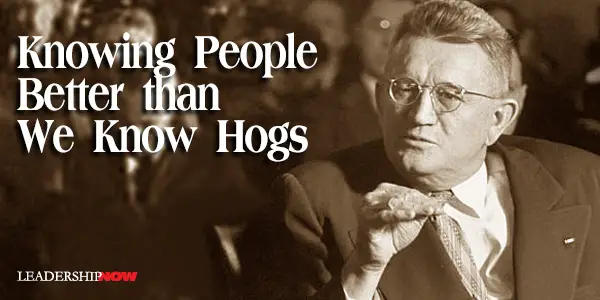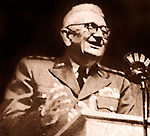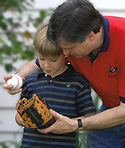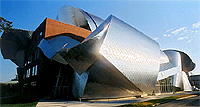 Leading Blog | Posts by Month |
 Leading Blog | Posts by Month |
06.29.06

Are You an Extreme Leader?The adventure race Primal Quest has attracted the attention of Daniel Wilson, a researcher with Project Zero, a program in Harvard's education school that studies how people learn, think and create. “Since 2002, Primal Quest has sent videographers along with the racers at various points on the trail. Wilson has watched hundreds of hours of footage, analyzing how teams behave in high-stress situations,” reports Hannah Clark in Forbes. It's clear from the footage why some teams succeed and others struggle. Wilson only studied teams that completed the race, but even among finishers the differences are stark. On the top squads, every team member participates in decision-making, and everyone takes a leadership role at some point in the race. On the lower-performing teams, by contrast, one person often dominates discussions. "It's very, very clear in the interaction patterns how these top teams are so successful," Wilson says.Below are several of the 10 leadership skills of an endurance racer that Ms. Clark lists in her article: Sharing Leadership: One person can't bear the entire burden of leading a team. That person is bound to get tired, or stressed, and other team members need to pick up the slack. On the best endurance racing teams, everyone leads at some point during the race. Shifting Roles: During endurance races, it's important multiple team members have navigation skills. On one poor-performing team, the captain never let go of the map. On the best teams, however, multiple members had strong navigation skills, and they all consulted about the best routes to take. "If the group only has one role as a navigator, that team is going to struggle," says Harvard researcher Daniel Wilson. Seeking Information: Ask questions. The top teams are aware of what they know and equally cognizant of what they don't. Asking questions doesn't expose a weakness; it helps your team gather as much information as possible and explore different ideas and proposals. Closing The Loop: Every time someone says something, someone else should respond. This is called "closing the loop," and while it's ubiquitous on top teams, it's rare on the poor performers. It keeps the discussion on one track, avoiding the confusion that plagued Team Kool n' Fit. It also reduces stress. "They're facing so many factors like fatigue," Wilson says. "The cognitive load is very high. If you acknowledge someone's message is received, it's one less thing they have to worry about." Setting Goals: In high-stress situations, team members should discuss their goals and the plan for achieving them. "As a team, if you don't have the same goals, you're just headed for disaster," says Brazeau. While teams must make some plans ahead of time, they must be able to evaluate and adjust as circumstances change.
Posted by Michael McKinney at 09:40 AM
06.26.06

Leadership and IntelligenceTraditional measures of intelligence don’t always predict leadership success. Elizabeth Station recently highlighted in Notre Dame Business recent research by Amy E. Colbert, Timothy Judge, and Remus Ilies, published in the June 2004 Journal of Applied Psychology. The findings were based on 151 independent studies that probed the intelligence-leadership connection and showed that “the relationship between intelligence and leadership is considerably lower than previously thought.” They found only a moderate link between the two.Perceptual measures of intelligence showed stronger correlations with leadership than did traditional paper-and-pencil measures of intelligence. In other words, appearing smart may have a greater impact on perceptions of leadership ability than being smart. Not really surprising. They also reported that "the leader's stress level and the leader's directiveness moderated the intelligence-leadership relationship." Station asks: "So if brains aren’t paramount, what qualities do matter most? Leaders are usually extroverted, conscientious, open and emotionally stable, according to previous research. Intelligence is important when combined with attributes like motivation, persistence and dominance."
Posted by Michael McKinney at 12:02 PM
06.22.06

Whole Leadership They have found that many business leaders today are “searching for the key personal quality that will somehow make them successful or whole.” Yet, “quite often, what they need already exists within them but is unrecognized or underdeveloped.” They suggest that mature leaders “often display head, heart, and guts naturally.” Based on years of experience they have developed the wisdom that comes with maturity. They have learned to be flexible and apply the right capacity as the context demands. They note: Maturity doesn’t mean becoming one-third head, one-third heart, and one-third guts. Everyone has a natural leadership style, and a natural tendency to lean on intellect, emotion, or courage doesn’t change with maturity. What does change is a willingness to consider options that don’t fit in with one’s natural style.Unfortunately, companies can’t wait for all of their leaders to become mature so they must learn to develop leadership maturity. While there is no one-size-fits-all formula, this process begins by determining the dominate head, heart or gut orientation of the company. From there, the focus should be on “helping the leadership population increase their capacity in the less dominate areas.… [O]ne goal in developing leadership maturity is to help leaders to recognize how over-reliance on their dominate style prevents them from being successful.” This is not always easy as most leaders think they are more adept at moving from one to the other than they really are. The authors suggest ways to help leaders develop their capacity in all three areas. In today’s environment where the context is constantly shifting, understanding the situation is crucial to success. It is helpful to consider these ideas from a context-versus-content perspective. Content leaders are classic head types, feeling compelled to draw on their knowledge to add value when they meet with others. Context leaders, on the other hand, add value by recognizing other resources when they enter a room and use them effectively. Operating with a context requires heart and guts; these leaders need to take the risk of depending on others to add value, and they must connect with other people so that they are willing to help them accomplish their objectives…. It is less important to them to be seen as the cleverest person around, than to be able to use their head, heart, and guts as the situation requires.
Posted by Michael McKinney at 11:00 AM
06.19.06

Knowing People Better than We Know Hogs
 On July 31, 1941, Franklin Roosevelt named Hershey the director of the Selective Service System a position he held for almost 30 years. Needless to say, this was a difficult assignment. He had to get congress what they needed in the framework of what Americans would accept. His leadership style, humility, and sense of humor helped him to walk this tightrope. As a nationally renowned speaker, he used his Hoosier wit and philosophy to charm his audience. Another great Hershey statement: “A boy becomes an adult three years before his parents think he does, and about two years after he thinks he does.”
Posted by Michael McKinney at 12:13 PM
06.16.06

The Fred Factor for Kids ... Too
I thought I'd pass this along for the Father's Day weekend. This is a timely piece from Mark Sanborn author of The Fred Factor one of our picks for Best Leadership Books of 2004. Mark writes: Proverbs 22:6 says, Train a child in the way he should go, and when he is old he will not turn from it. Check out the Fred Factor Web Site for resources and to subscribe to The Fred Factor eZine.
Posted by Michael McKinney at 01:20 PM
06.15.06

Fathers: Raise A Generation of Outstanding Leaders
THE National Fatherhood Initiative has found that 24-million American children (over a third of all kids in the U.S.) live in homes without their biological father. Additionally, the absence of a dad from so many homes plays a direct role in a number of social ills. Kids in father-deprived homes are more likely to be abused, poor, prone to drug abuse, prone to poor scholastic achievement, and prone to emotional and behavior problems including suicide and crime. A study if violent criminals in U.S. prisons showed that prison populations are overwhelmingly made up of males who grew up without fathers. 60% of convicted rapists, 72% of adolescent murderers, and 70% of all long-term prison inmates came from fatherless homes.  Pat Williams has been going about the country for years stressing the need for fathers and their role in raising leaders. He insists that no child is too young to begin to develop traits that will serve to help them become outstanding leaders. He writes: Kids want to lead. They enjoy setting goals and then taking the steps to achieve those goals. When do kids become bored? When they feel they are being forced to do something they don’t care about. When do they rebel? When they feel they are being told what to do and how to do it. But give them a chance to lead, give them the opportunity and responsibility to make their own decisions, and they will astonish you with their ability to get things done.  You can read an excerpt of The Warrior Within. He is also the author of Coaching Your Kids to Be Leaders.  
Posted by Michael McKinney at 12:24 PM
06.12.06

Five Great Innovation Myths
BOEING'S former Chairman and CEO, Jim McNerney delivered a speech to the National Center for Healthcare Leadership and he spoke about innovation. He stressed that innovation is a team sport. It is best brought about by people working together across different groups and organizational lines. And it ought to be part of everyone’s job. He asks, how do you cultivate innovation? For starters, you should do no harm. Unfortunately, there are a number of popular but damaging misconceptions about innovation. From personal experience, I have seen how these romantic but misguided notions can lead to dysfunctional behavior—serving only to discourage creativity and growth. So here are five great innovation myths (Do you see these in your organization?): 3M was one of those companies that were faced with this transition. It had lost its edge on the real reasons why innovation happens. McNerney added: The team and I set out to change the mindset of the company in two basic ways: He concluded with:  I opened this discussion with the Apollo 13 story because it illustrates what an organization on the top of its form can do, in bouncing back from near catastrophe. The astronauts and the ground crews came up with one innovation after another—and none of those innovations, I might add, was especially high-tech. What they really involved was the brilliant use of scarce resources, a magnificent display of teamwork across a large organization, and the kind of gutsy decision-making that is the true mark of an organization with a high leadership component.
Posted by Michael McKinney at 07:31 AM
06.08.06

The Skilling TrapMark Gimein wrote a great analysis of the Enron scandal in Business Week. In The Skilling Trap, he hits the nail on the head. But there's more to it. "That's the way the system works." It's a strange thing for a man to say who has been convicted of 19 separate criminal charges. Reduced to words on a page, you can imagine the tone to be bitter or accusing. But it's not. Nor is it gallows humor, a tip of the hat to the prosecutors who won their case, but something more poignant.It’s easy to blame the system, but the system isn’t something outside ourselves, some vast unseen force putting pressure on us to do things we don’t want to do. We are the system. It works that way because we work that way. It won’t change until we do. Adding more laws can’t protect us from ourselves. What is lacking here is character and the integrity to maintain right principles even at a personal loss. Gimein continues and address the spirit of the law: But what made Enron possible was not a lack of rules. It was an unwillingness to think about regulation and responsibility in any but the most legalistic terms.The Skilling Trap is that trap you fall into when you don’t see beyond the letter of the law. Sadly most laws are in place because we substitute what’s legal for what’s ethical. They are not the same. It’s a tug of war we have all experienced. Ethical addresses what should I do. Legal is about what do I have to do. If legal is the only consideration then caution is the watchword. Ethics is about principles and responsibilities. As Mark Gimein observes, the issue is failure to deal with the spirit of the law. If your actions are right but your attitude is wrong, it will eventually catch up with you. When leaders are looking out for themselves—when leaders are in it for what they can get not for what they can give—we have Enrons. Leadership is about service and looking out for those you are responsible for. Some readers will yawn at this, but character is a real issue with real consequences.
Posted by Michael McKinney at 10:06 AM
06.05.06

Three Theories Are Better Than One
 You can, of course, take this too far and get caught up in all sorts of mind games and become mired in overanalyzing. This generally isn’t our problem, however. We tend to jump to generalizations and oversimplifications without a clear understanding of reality, thus repeating the same old thinking. We need to cast a wider net, asking more and different questions. We need to keep a balance. Concerning theories, Perry thought it was worth noting: “The wisdom doesn't come from the theories; the theories come from the wisdom. And the wisdom comes from the defeat of all the more attractive alternatives.” And in a cautionary tone, “With all these theories, it would be a good thing, of course, to keep an open mind. But the problem with an open mind is that it's so drafty.”
Posted by Michael McKinney at 06:00 AM
06.01.06

Problem Solving with a Design Attitude
PROFESSORS Richard Boland and Fred Collopy from the Case Western Reserve University’s Weatherland School of Management had the opportunity to work with Frank O. Gehry on the management schools new building. The design process exposed them a problem solving approach they call a design attitude.  We believe that if managers adopted a design attitude, the world of business would be different and better. Managers would approach problems with a sensibility that swept in the broadest array of influences to shape inspiring and energizing designs for products, services, and processes that are both profitable and humanly satisfying. Working with Gehry has led them to see “how both management practice and education have allowed a limited and narrow vocabulary of decision making to drive an expansive and embracing vocabulary of design out of circulation. In our focus on teaching students advanced analytical techniques for choosing among alternatives, our attention to strengthening their design skills for shaping new alternatives has withered.” The most dominate approach we see today they call the decision attitude. This approach uses mathematical and scientific approaches—economic analysis, risk assessment, multiple criteria decision making, simulation, and the time value of money—to choose among alternatives. “It starts with the assumption that the alternative courses of action are ready at hand—that there is a good set of options already available, or at least readily obtainable. “ The design attitude on the other hand assumes the best alternative may have to be invented. Design thinking doesn’t mean bringing more creativity to bear. “Creativity itself is not going to bring us to the organizational, product, or process innovations we require. Creativity needs the guiding energy of a design attitude in order to focus our efforts on results that will be truly innovative and produce long-lasting organizational betterments.” Design is in that sense larger than creativity. Design provides a context for creativity by channeling it toward humanly satisfying purposes, and that is why we cannot allow calls for increased creativity and techniques for enhancing creativity to take the place of increased attention to s design attitude in management practice and education. The illustration below from The Central Office of Design adds a graphic explaination of design thinking.
They explain on their web site that they "start each project assuming nothing, especially about what the solution to the problem might be, and embark on the process with empathy for the final consumer of the solution. Whether it be an employee, child, or mother of three."
Posted by Michael McKinney at 12:36 AM
|
BUILD YOUR KNOWLEDGE


How to Do Your Start-Up Right STRAIGHT TALK FOR START-UPS 
Grow Your Leadership Skills NEW AND UPCOMING LEADERSHIP BOOKS 
Leadership Minute BITE-SIZE CONCEPTS YOU CAN CHEW ON 
Classic Leadership Books BOOKS TO READ BEFORE YOU LEAD |
|